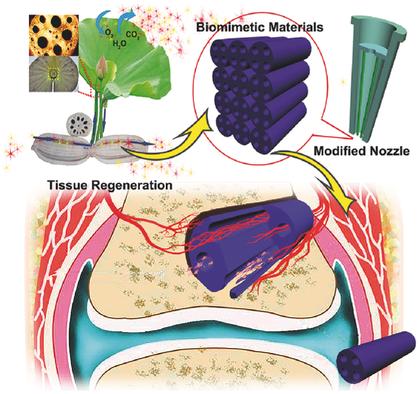Our official English website, www.x-mol.net, welcomes your feedback! (Note: you will need to create a separate account there.)
3D Printing of Lotus Root‐Like Biomimetic Materials for Cell Delivery and Tissue Regeneration
Advanced Science ( IF 15.1 ) Pub Date : 2017-10-26 , DOI: 10.1002/advs.201700401 Chun Feng 1, 2 , Wenjie Zhang 3 , Cuijun Deng 1, 2 , Guanglong Li 3 , Jiang Chang 1 , Zhiyuan Zhang 4 , Xinquan Jiang 3 , Chengtie Wu 1
Advanced Science ( IF 15.1 ) Pub Date : 2017-10-26 , DOI: 10.1002/advs.201700401 Chun Feng 1, 2 , Wenjie Zhang 3 , Cuijun Deng 1, 2 , Guanglong Li 3 , Jiang Chang 1 , Zhiyuan Zhang 4 , Xinquan Jiang 3 , Chengtie Wu 1
Affiliation

|
Biomimetic materials have drawn more and more attention in recent years. Regeneration of large bone defects is still a major clinical challenge. In addition, vascularization plays an important role in the process of large bone regeneration and microchannel structure can induce endothelial cells to form rudimentary vasculature. In recent years, 3D printing scaffolds are major materials for large bone defect repair. However, these traditional 3D scaffolds have low porosity and nonchannel structure, which impede angiogenesis and osteogenesis. In this study, inspired by the microstructure of natural plant lotus root, biomimetic materials with lotus root‐like structures are successfully prepared via a modified 3D printing strategy. Compared with traditional 3D materials, these biomimetic materials can significantly improve in vitro cell attachment and proliferation as well as promote in vivo osteogenesis, indicating potential application for cell delivery and bone regeneration.
中文翻译:

3D打印莲藕仿生材料用于细胞输送和组织再生
近年来,仿生材料越来越受到人们的关注。大骨缺损的再生仍然是一个重大的临床挑战。此外,血管化在大骨再生过程中起着重要作用,微通道结构可以诱导内皮细胞形成初级脉管系统。近年来,3D打印支架是大面积骨缺损修复的主要材料。然而,这些传统的3D支架具有低孔隙率和非通道结构,阻碍了血管生成和成骨。本研究受天然植物莲藕微观结构的启发,通过改进的3D打印策略成功制备了具有莲藕结构的仿生材料。与传统的3D材料相比,这些仿生材料可以显着改善体外细胞附着和增殖,并促进体内成骨,表明在细胞输送和骨再生方面具有潜在的应用前景。
更新日期:2017-10-26
中文翻译:

3D打印莲藕仿生材料用于细胞输送和组织再生
近年来,仿生材料越来越受到人们的关注。大骨缺损的再生仍然是一个重大的临床挑战。此外,血管化在大骨再生过程中起着重要作用,微通道结构可以诱导内皮细胞形成初级脉管系统。近年来,3D打印支架是大面积骨缺损修复的主要材料。然而,这些传统的3D支架具有低孔隙率和非通道结构,阻碍了血管生成和成骨。本研究受天然植物莲藕微观结构的启发,通过改进的3D打印策略成功制备了具有莲藕结构的仿生材料。与传统的3D材料相比,这些仿生材料可以显着改善体外细胞附着和增殖,并促进体内成骨,表明在细胞输送和骨再生方面具有潜在的应用前景。


























 京公网安备 11010802027423号
京公网安备 11010802027423号